The cryptocurrency market is highly sensitive to macro trends, and traders adjust their positions based on liquidity, interest rate expectations, and the economic environment. Market volatility is expected to increase significantly before and after the release of major economic data.
Key Highlights
– Central bank decisions impact market liquidity: Interest rate hikes tighten liquidity, putting pressure on cryptocurrencies; a pause or rate cut may drive speculative funds into the market. The policies of the Federal Reserve (Fed), European Central Bank (ECB), and Bank of England (BoE) will be key driving factors for the market.
– Inflation and economic growth determine risk appetite: Cooling inflation and strong economic growth are favorable for the crypto market, while soaring inflation or weak economic data may trigger market sell-offs. Key data includes CPI (Consumer Price Index), PPI (Producer Price Index), GDP (Gross Domestic Product), and employment data.
– Geopolitical and regulatory dynamics increase market volatility: Escalation of the Russia-Ukraine war, heightened US-China tensions, or conflicts in the Middle East may trigger a rise in risk-averse sentiment. However, positive regulatory developments, such as ETF approvals or progress on MiCA (Markets in Crypto-Assets), may boost market confidence.
– Market sentiment and capital rotation are crucial: The cryptocurrency market is extremely sensitive to macro trends, and traders adjust their positions based on liquidity, interest rate expectations, and the economic environment. Market volatility is expected to increase significantly before and after the release of major economic data.

As the cryptocurrency market matures, the impact of macroeconomic events on digital asset price trends is becoming increasingly significant.
Economic indicators, central bank policy decisions, inflation reports, and geopolitical developments all affect traders' risk appetite. Whether you are a short-term crypto trader or a long-term investor, paying attention to key economic events in March will help you better navigate market volatility.
In this article, we will break down the most important economic events in March—from central bank interest rate decisions, inflation data, employment reports to global political dynamics—and analyze how they affect the crypto market. Although the prices of crypto assets are often uniquely influenced by blockchain technology and digital asset innovations, the macroeconomic environment still determines investors' confidence and positioning strategies in risk assets such as cryptocurrencies.
Table of Contents
Central Bank Meetings and Interest Rate Decisions
– Federal Open Market Committee (FOMC) – March 18–19
– European Central Bank (ECB) – March 5–6
– Bank of England (BoE) – March 20
– Bank of Japan (BoJ) – March 18–19
– Other central banks (Bank of Canada BoC, Swiss National Bank SNB, Reserve Bank of Australia RBA)
– US inflation data (CPI: March 12, PPI: March 13)
– Eurozone Consumer Price Index (March 3)
– UK inflation report (March 26)
– Inflation data from China and emerging markets
– US Non-Farm Payroll (NFP) report – March 7
– Unemployment rate and wage growth trends
– JOLTS (Job Openings and Labor Turnover Survey) – March 11
GDP (Gross Domestic Product) Reports
– US Q4 2024 final estimate – March 27
– UK GDP report – March 14
– China economic outlook (National People's Congress & Q1 2025 forecast)
– PMI Purchasing Managers' Index (business confidence) – early March
– US retail sales & consumer confidence index – mid to late March
– Industrial production and trade data (output, exports, durable goods orders)
Global Political Developments Impacting the Cryptocurrency Market
– Russia-Ukraine war and market sentiment
– US-China relations and trade war
– Middle East and other geopolitical hotspots
Cryptocurrency Regulation and Policy Changes
– US SEC regulation & cryptocurrency laws
– MiCA framework & European crypto regulatory policies
– US debt ceiling and fiscal policy impacts
Developments in Major Economies and Investor Sentiment
– US economic outlook & Federal Reserve policy
– Eurozone economic balancing strategies
– China economic growth targets & stimulus policies
– Emerging markets and capital flow trends
Impact on the Cryptocurrency Market in March
Central Bank Meetings and Interest Rate Decisions
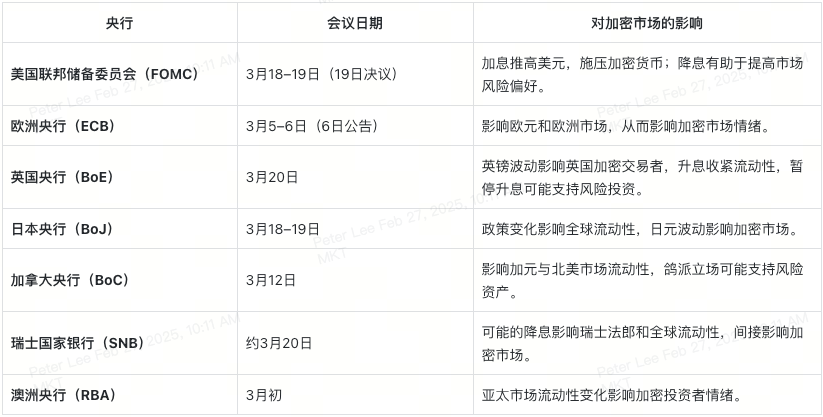
Federal Reserve (FOMC)
Meeting Dates: March 18–19 (Decision Announcement: March 19)
Impact Analysis:
The Federal Reserve's interest rate policy is a significant driving force in global markets and directly affects the cryptocurrency market. Investors will closely monitor whether there is a change in policy direction.
Why is it important?
– Hawkish policy: Maintaining high interest rates will strengthen the dollar and put pressure on the crypto market.
– Dovish policy: If the Fed pauses rate hikes or cuts rates, bond yields may decline, attracting speculative funds into the market, such as Bitcoin and other risk assets.
– The Fed's decision statement and press conference typically trigger significant market volatility.
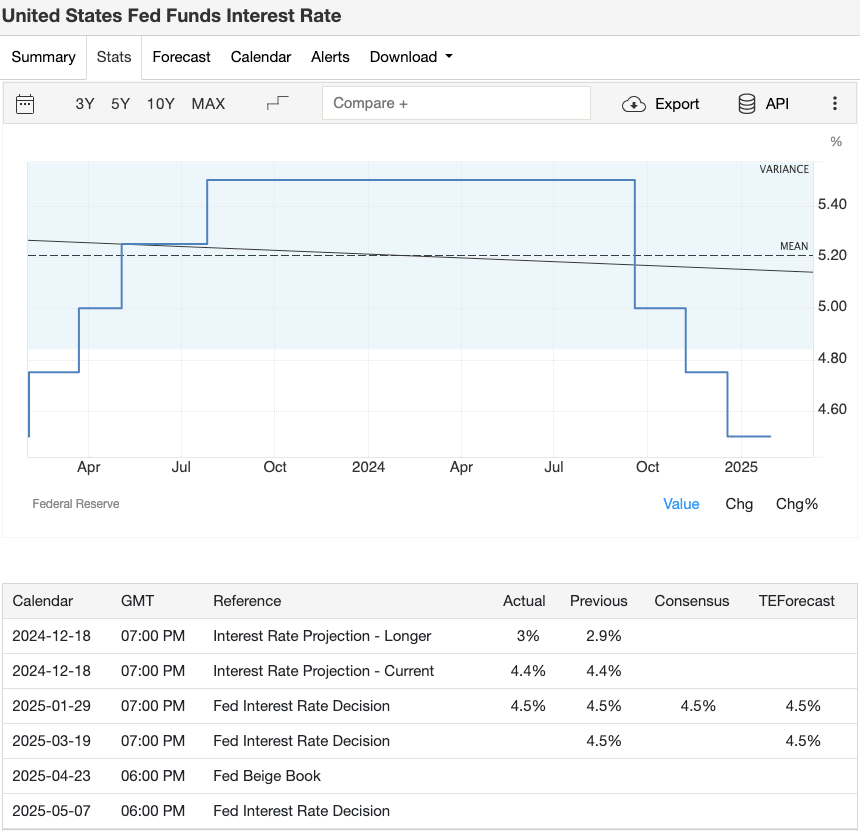
Image Credit: Trading Economics
European Central Bank (ECB)
Meeting Dates: March 5–6 (Decision Announcement: March 6)
Impact Analysis:
The ECB is working to balance inflation control with economic recovery.
Why is it important?
– ECB policy directly impacts the euro and European markets, and indirectly affects cryptocurrency market sentiment.
– If the ECB signals a pause in rate hikes, investors' risk appetite may increase.
– If the ECB continues to raise rates or maintains a hawkish stance, the crypto market may face pressure.
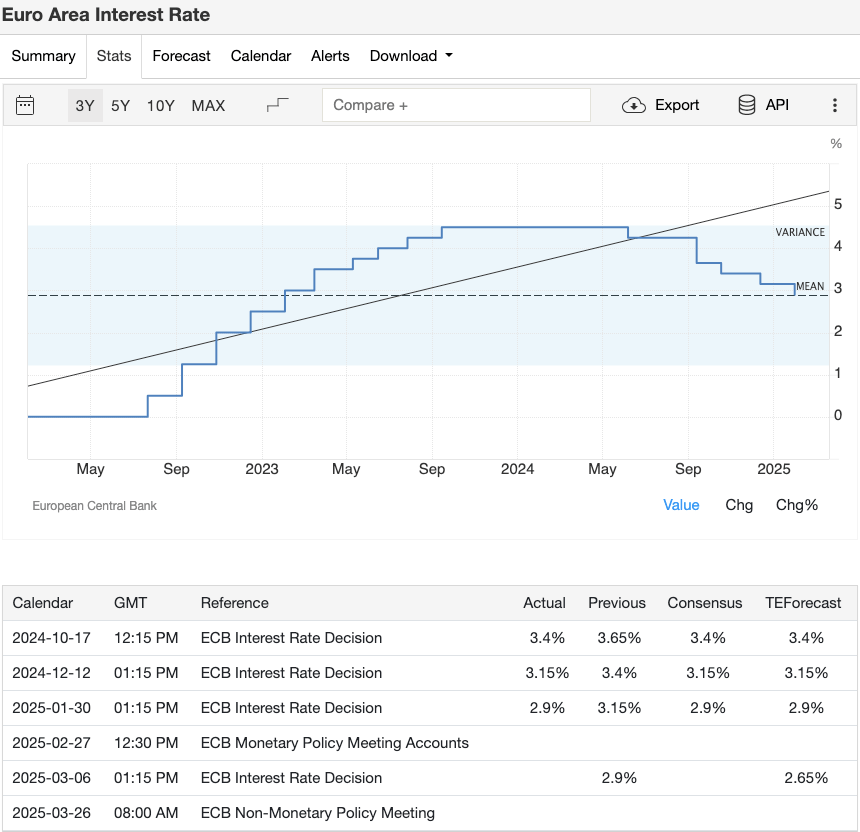
Image Credit: Trading Economics
Bank of England (BoE)
Meeting Date: March 20
Impact Analysis:
UK inflation remains high, and the central bank needs to decide whether to continue tightening policy.
Why is it important?
– Fluctuations in the pound will affect UK cryptocurrency traders.
– If the BoE chooses to raise rates, market liquidity will tighten, potentially reducing interest in investing in crypto assets.
– If the BoE pauses rate hikes, it may encourage more funds to flow into risk assets, including cryptocurrencies.
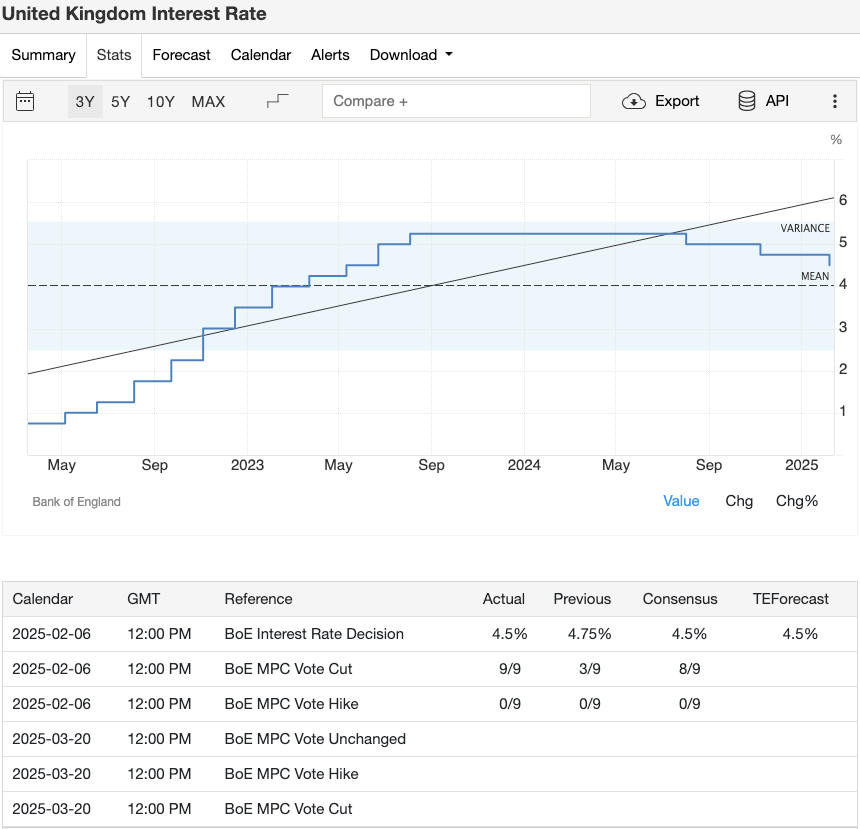
Image Credit: Trading Economics
Bank of Japan (BoJ)
Meeting Dates: March 18–19
Impact Analysis:
The BoJ is gradually adjusting its ultra-loose monetary policy, which will affect global liquidity.
Why is it important?
– A stronger yen may affect global market liquidity and influence short-term volatility in the crypto market.
– Policy adjustments may trigger fluctuations in yen-related trading pairs, impacting international capital flows.
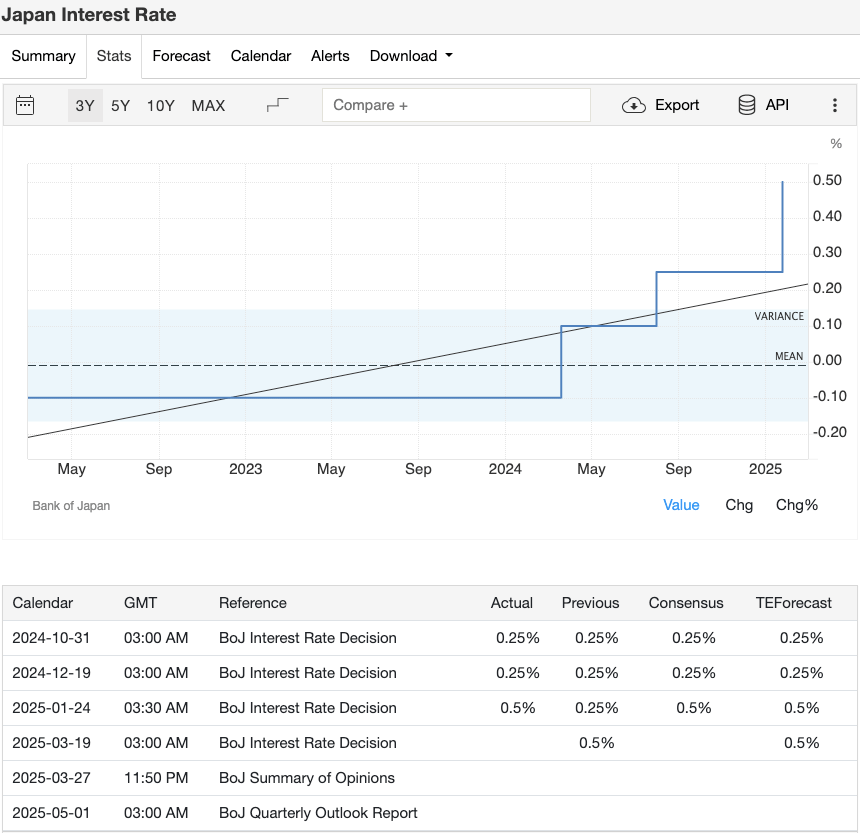
Image Credit: Trading Economics
Other Central Bank Dynamics
– Bank of Canada (BoC): Interest rate decision to be announced on March 12.
– Swiss National Bank (SNB): Possible adjustment to interest rate policy around March 20.
– Reserve Bank of Australia (RBA): Meeting scheduled for early March.
If multiple central banks adopt a dovish stance (such as cutting rates or pausing rate hikes), the financial environment may become more accommodative, supporting risk assets including cryptocurrencies. Conversely, if central banks continue hawkish policies (raising rates or signaling tightening), market liquidity may further tighten, putting pressure on digital assets.
Inflation Reports (CPI, PPI)
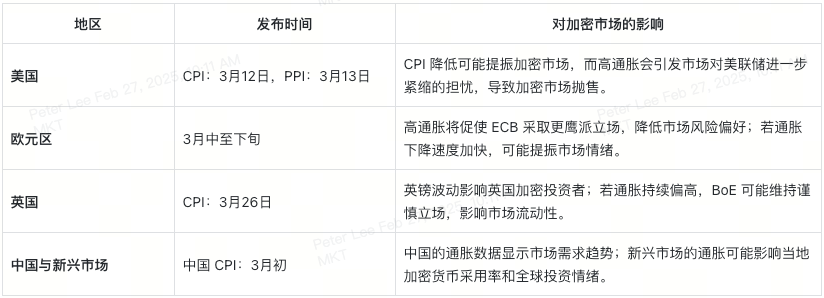
US Inflation Data
Release Dates:
– CPI (Consumer Price Index): March 12
– PPI (Producer Price Index): March 13
US inflation data is crucial for market interest rate expectations. If CPI comes in below expectations, it may bolster market confidence in the Fed pausing rate hikes, stimulating a rise in risk assets. Conversely, if CPI or PPI exceeds expectations, it may indicate persistent inflation, leading the market to worry about further tightening by the Fed, resulting in capital outflows from the crypto market.
Why is it important?
– The market typically rises in the context of cooling inflation, suggesting stable interest rates.
– High inflation may trigger sell-offs in both the stock and crypto markets.
– The market usually experiences significant volatility before and after these data releases.
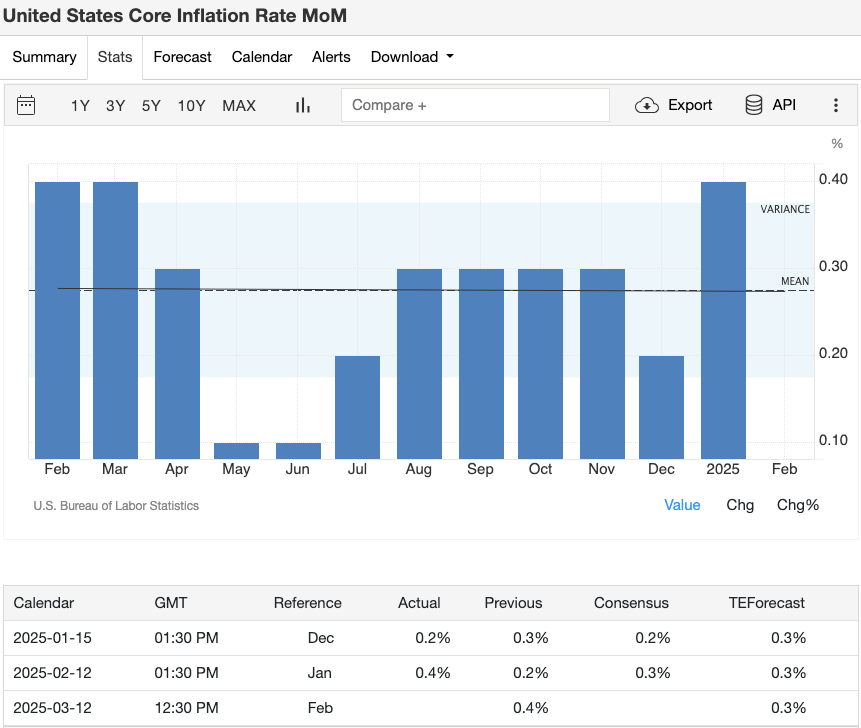
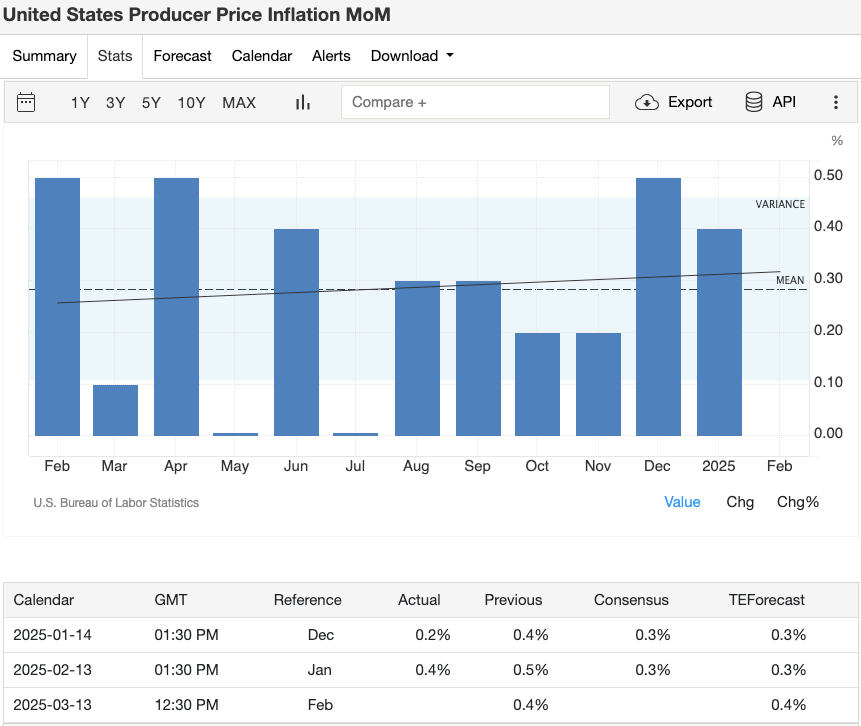
Image Credit: Trading Economics
Eurozone Consumer Price Index (CPI)
Release Date: March 3
Inflation in the Eurozone has been high for an extended period but has recently shown a downward trend.
Why is it important?
– Persistently high inflation may prompt the European Central Bank (ECB) to continue raising rates, suppressing market risk appetite.
– If inflation declines more rapidly, investor confidence may strengthen, indirectly benefiting the crypto market.
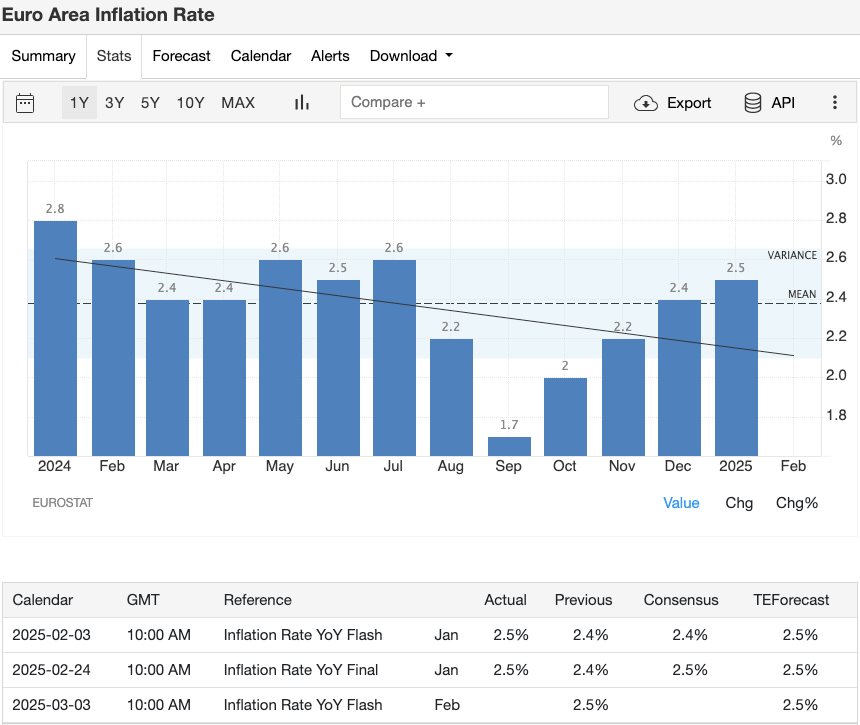
Image Credit: Trading Economics
UK Inflation Data
Release Date: March 26
The UK is still working to control high inflation, which will influence the Bank of England (BoE)'s interest rate decisions.
Why is it important?
– Fluctuations in the pound affect the trading strategies of UK crypto investors.
– Persistently high inflation may compel the BoE to maintain a tightening stance, weakening market liquidity.
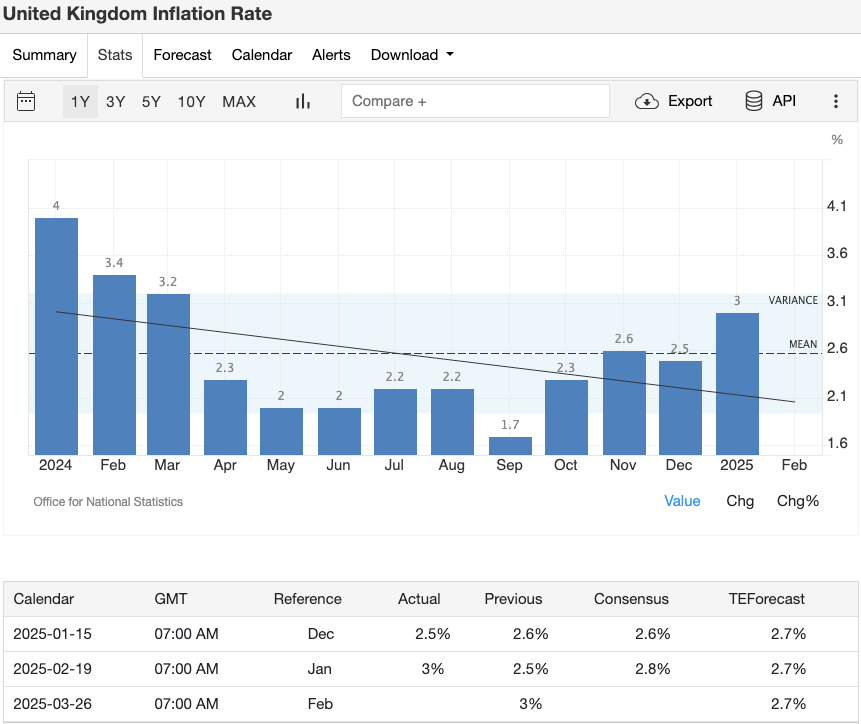
Image Credit: Trading Economics
Inflation Data from China and Emerging Markets
China CPI (Release Date: Early March)
China's inflation data reflects market demand, while inflation trends in emerging markets (such as Turkey, Brazil, etc.) influence local cryptocurrency adoption rates and global investment sentiment.
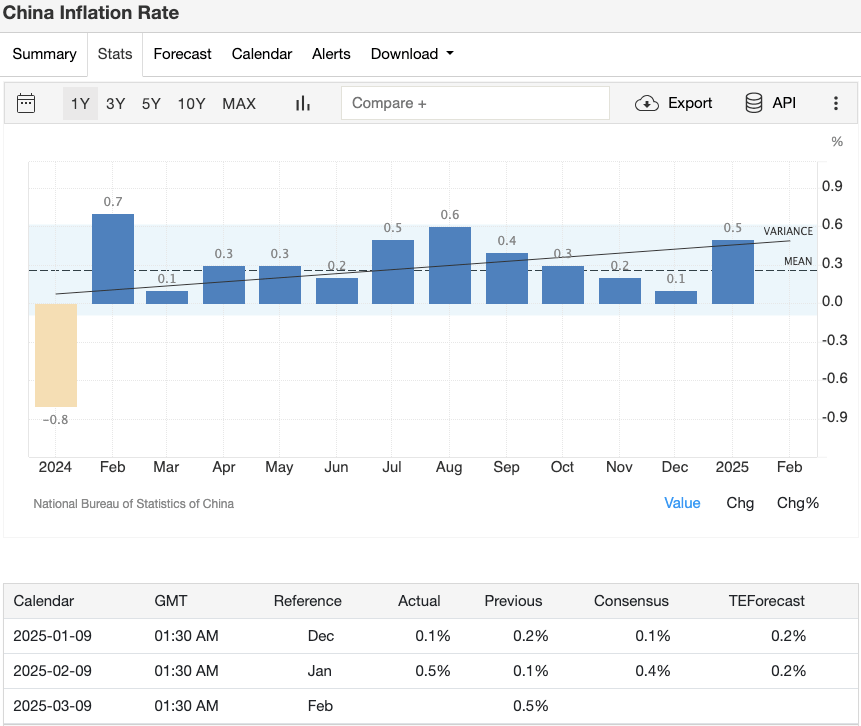
Image Credit: Trading Economics
Employment Data Releases

US Non-Farm Payroll (NFP) Report
Release Date: March 7 (Eastern Time 08:30)
NFP is an important indicator of the US economic condition, covering employment growth, unemployment rate, and wage data.
Why is it important?
– Strong NFP (high employment growth, low unemployment rate): The Fed may maintain a tightening policy, strengthening the dollar and putting pressure on the crypto market.
– Weak NFP (low employment growth, rising unemployment rate): This may enhance market expectations for Fed rate cuts, benefiting risk assets like Bitcoin.
– Extremely weak data may raise market concerns about an economic recession, potentially leading to a short-term influx of risk-averse capital into the dollar and gold, rather than cryptocurrencies.

Image Credit: Trading Economics
Unemployment Rate and Wage Growth
Changes in the unemployment rate and average hourly earnings affect market expectations for inflation and monetary policy.
Why is it important?
– Rapid wage growth: This may exacerbate inflation, prompting the Fed to maintain high rates, which is unfavorable for the crypto market.
– Rising unemployment rate: This may indicate an economic slowdown, weakening market confidence, but could also force the Fed to adopt a more accommodative policy, benefiting risk assets.
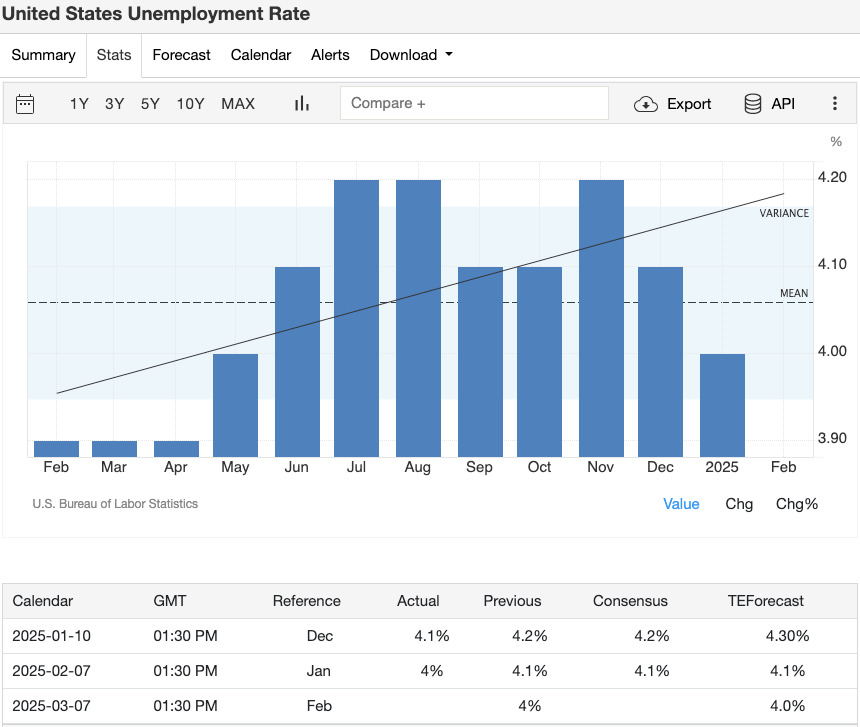
Image Credit: Trading Economics
JOLTS (Job Openings and Labor Turnover Survey)
Release Date: March 11
JOLTS data reflects the demand situation in the US labor market and influences bond markets and monetary policy expectations.
Why is it important?
– Decrease in job openings: Indicates a weak labor market, which may prompt the Fed to cut rates, benefiting the crypto market; however, if the decline is too rapid, it may raise market concerns about an economic recession.
– Increase in job openings: May indicate a still-strong economy, reducing market expectations for rate cuts, which is unfavorable for cryptocurrencies.
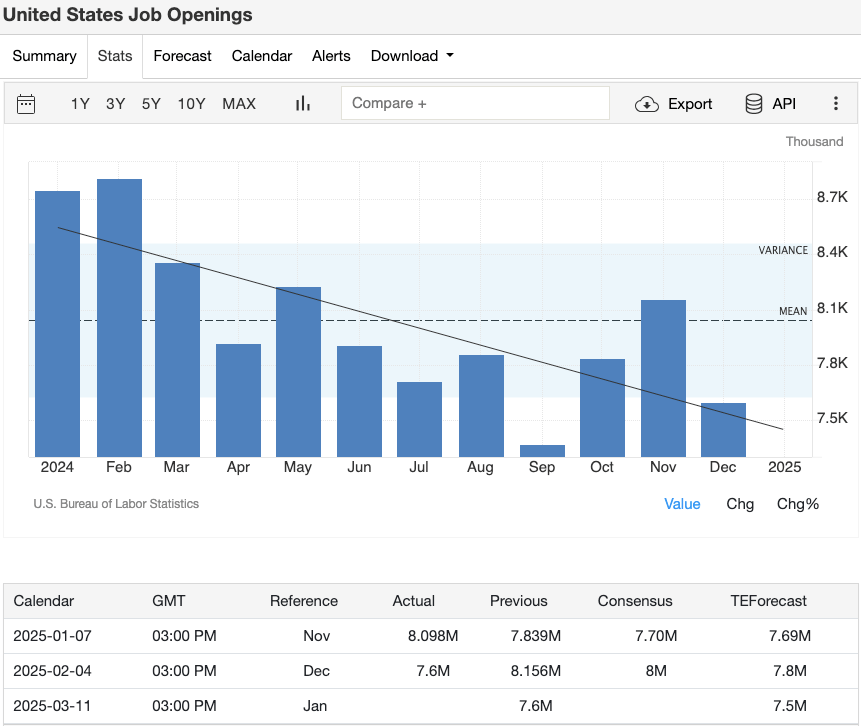
Image Credit: Trading Economics
GDP (Gross Domestic Product) Releases

US GDP (Final Estimate for Q4 2024)
Release Date: March 27 (Eastern Time 08:30)
Although GDP data is a lagging indicator, final revised data may still impact market sentiment.
Why is it important?
– If GDP is revised downward, it may exacerbate market concerns about an economic recession, affecting investor confidence in risk assets (including cryptocurrencies).
– If GDP is revised upward, it may indicate economic resilience, boosting market sentiment.
– The crypto market typically does not respond directly to GDP but pays attention to consumer spending and corporate profit data to assess changes in risk appetite.
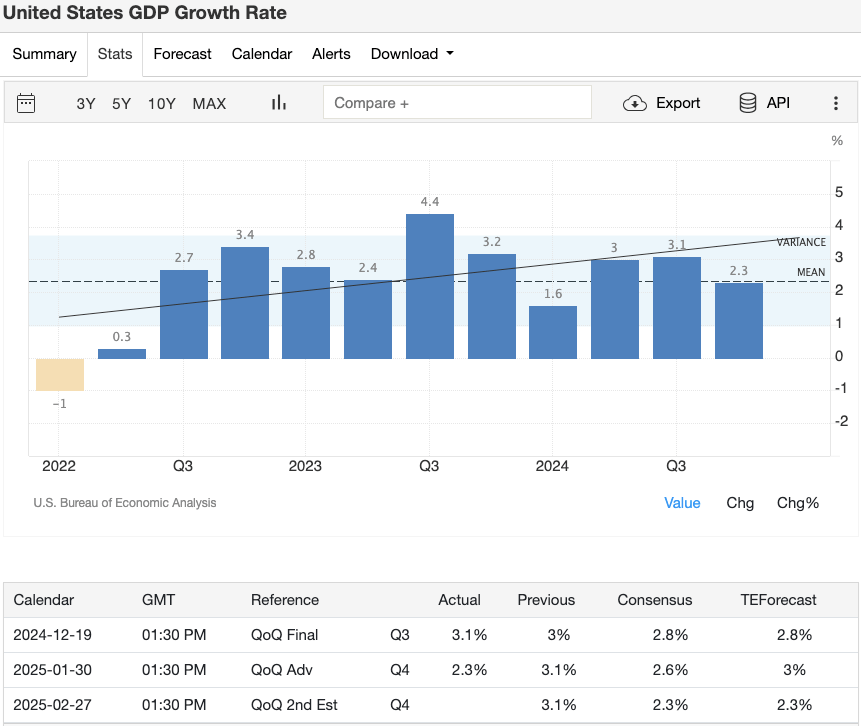
Image Credit: Trading Economics
UK GDP (Data for January 2025)
Release Date: March 14
Why is it important?
– The trend of European GDP affects global investment sentiment. If economic growth slows, it may suppress demand for risk assets.
– If GDP exceeds expectations, it may stabilize the market and promote investor interest in cryptocurrencies.
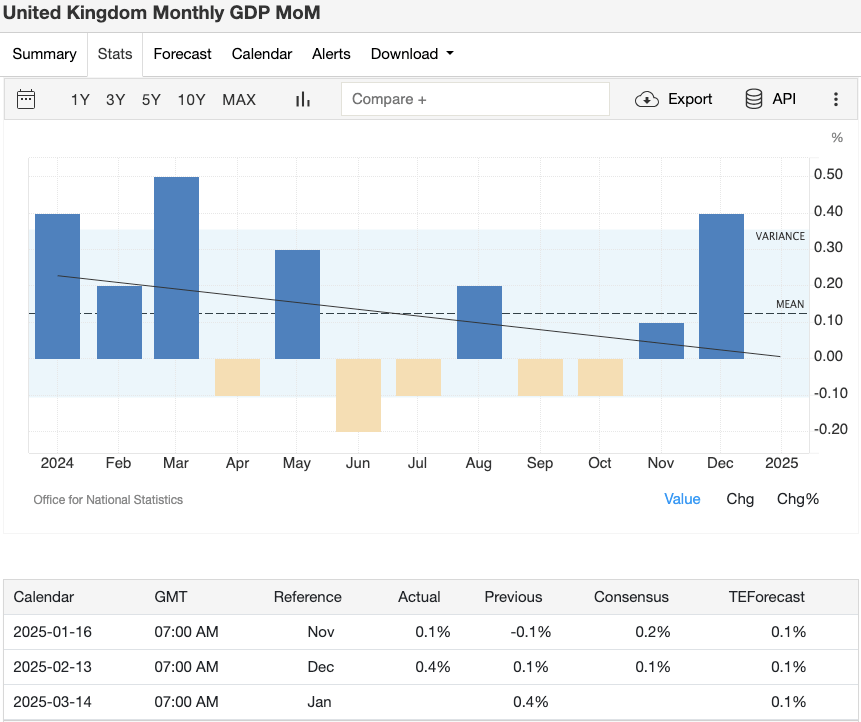
Image Credit: Trading Economics
China GDP (Q1 2025 Data)
Release Date: April (Economic growth target set during the National People's Congress in March)
Why is it important?
– Strong economic growth in China may drive up commodities and emerging markets, indirectly promoting capital inflows into the crypto market.
– Although China has banned domestic crypto trading, policy signals from Beijing still influence global liquidity and investor risk appetite.
Other Key Economic Indicators

PMI Purchasing Managers' Index (PMI Surveys)
Release Date: Early March (February PMI Data)
PMI measures the business confidence index for manufacturing and services, with data above 50 indicating economic expansion and below 50 indicating contraction.
Why is it important?
– Strong PMI (>50): Boosts risk appetite and may promote capital inflows into the crypto market.
– Weak PMI (50): Indicates economic slowdown, which may weaken market confidence and affect demand for high-risk assets like Bitcoin.
– Key data includes the US ISM Manufacturing PMI, Eurozone PMI, and China's official PMI.

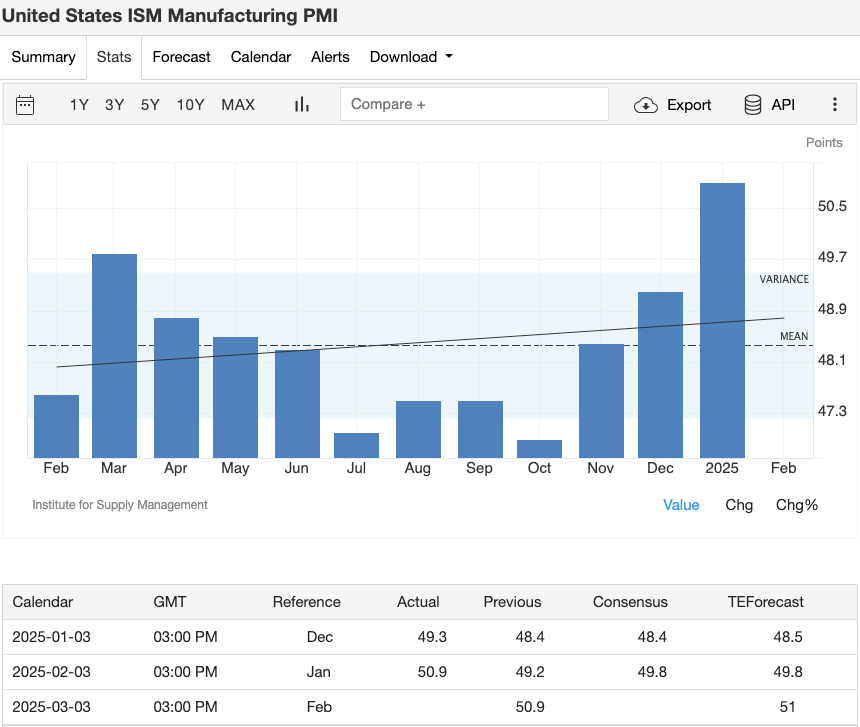
Image Credit: Trading Economics
Retail Sales and Consumer Confidence Index
Release Dates:
US Retail Sales (February Data): Mid-March
Consumer Confidence Index:
– Conference Board: March 26
– University of Michigan: Mid-March
Why is it important?
– Weak retail sales may indicate that rate hikes have affected consumer spending, weakening market confidence.
– High consumer confidence may indicate economic stability, helping to drive growth in risk assets like the crypto market.
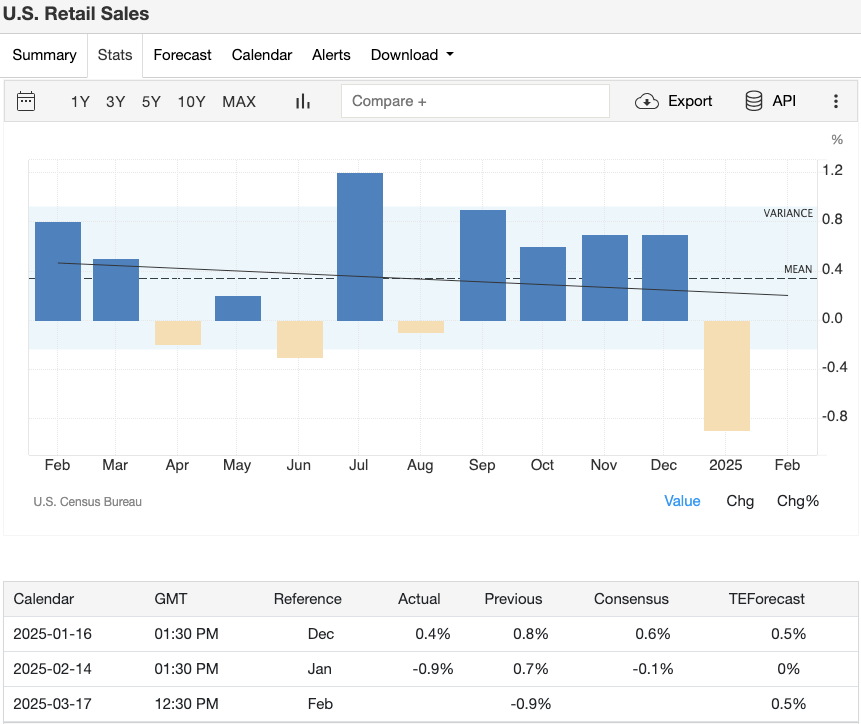
Image Credit: Trading Economics
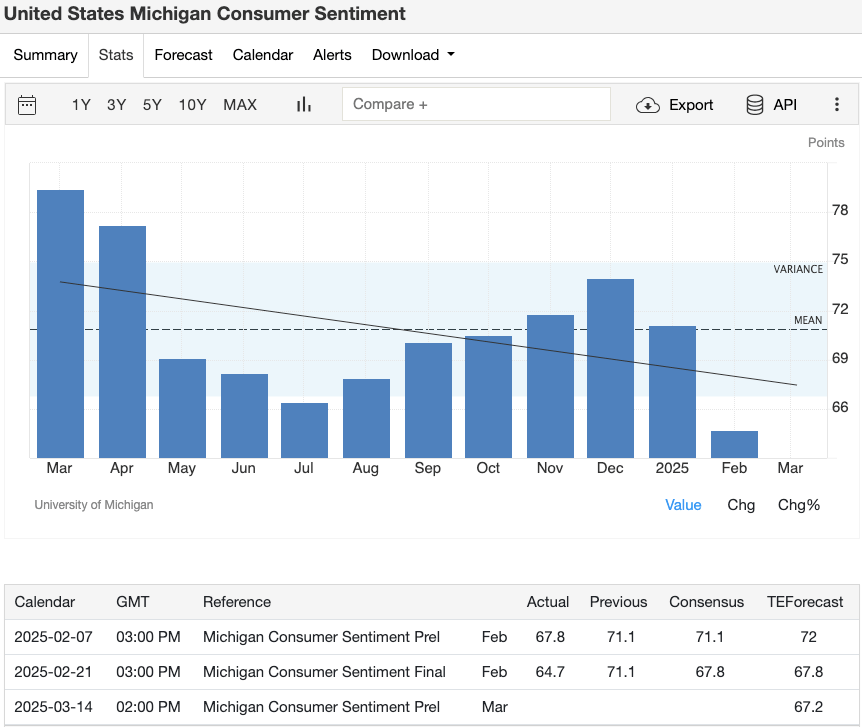
Image Credit: Trading Economics
Industrial and Trade Data
Coverage: Industrial production, durable goods orders, and trade balance data
Why is it important?
– These indicators affect currency values and bond yields.
– Sustained strong or weak data may change overall market sentiment, impacting cryptocurrency trends.
Global Political Developments Affecting the Crypto Market
Russia-Ukraine War
The Russia-Ukraine conflict has lasted nearly three years, and the market is highly sensitive to escalations in hostilities or peace negotiations. When geopolitical risks rise, funds typically flow into safe-haven assets like the dollar and gold, while risk assets (like Bitcoin) face pressure.
Factors that may affect the crypto market:
– Expansion of sanctions: If the US or EU imposes a new round of sanctions on Russia, it may affect global market liquidity and indirectly impact cryptocurrency prices.
– Escalation of military conflict: Intensified warfare may increase market risk aversion, weakening investment confidence in the crypto market.
– Diplomatic breakthroughs: If a ceasefire agreement or progress in negotiations occurs, market risk appetite may rebound, benefiting risk assets like Bitcoin.

Image Credit: Latest News and Updates
US-China Relations and Trade War
The US-China trade war, technology sanctions, and the situation in the Taiwan Strait continue to impact global markets. Recently, the US has imposed tariffs on Chinese imports, further increasing market uncertainty and leading to heightened volatility in risk assets, including cryptocurrencies.
Why is it important?
– Escalation of the trade war may increase inflationary pressures, affecting Fed policy and subsequently impacting risk assets like Bitcoin.
– Supply chain disruptions may affect global economic stability, typically unfavorable for the crypto market.
– Bitcoin as a safe-haven asset: Some investors view Bitcoin as a hedge against inflation, but historically, the uncertainty brought by trade wars tends to suppress the crypto market in the short term.
– If progress is made in US-China trade negotiations or a new trade agreement is reached, market confidence may rebound, benefiting the digital asset market.

Image Credit: International Relations Edu
Conflicts in the Middle East and Other Regions
Geopolitical hotspots in the Middle East, such as tensions between Israel and Iran, OPEC+ oil production decisions, and energy supply disruptions, may lead to rising oil prices, further exacerbating inflationary pressures and prompting investors to choose safe-haven assets.
Why is it important?
– Soaring oil prices: Typically drive up inflation, prompting central banks to maintain tighter monetary policies, which is unfavorable for risk assets like cryptocurrencies.
– Rising risk aversion: Investors may reduce their holdings in speculative assets (like Bitcoin).
– Use of cryptocurrencies in high-risk areas: In extreme cases, cryptocurrencies have been used for cross-border transactions or as financial safe havens in countries experiencing currency devaluation or financial system instability.

Image Credit: Arabian Business
Cryptocurrency Regulation and Policy Changes
Recently, regulatory policies in the US and Europe have changed, affecting institutional adoption, enforcement actions, and investor confidence.
Cryptocurrency Regulatory Developments
US Regulatory Updates:
– On February 20, 2025, the US Securities and Exchange Commission (SEC) established the Cyber and Emerging Technologies Unit (CETU), replacing the former Crypto Assets and Cyber Unit, focusing on combating fraud and protecting retail investors.
– The SEC has concluded its investigations into OpenSea and Coinbase, indicating a potentially more lenient regulatory stance towards the crypto industry.
European Regulatory Updates:
- – The MiCA (Markets in Crypto-Assets) regulatory framework is advancing, with the EU releasing technical standards on February 20, 2025, which will officially take effect on March 12, 2025, aiming to unify cryptocurrency regulatory standards across Europe.
Why is it important?
– The SEC's stance may have softened, benefiting innovation in the crypto industry, but the establishment of CETU indicates that enforcement efforts remain.
– The advancement of the MiCA regulatory framework will standardize regulatory rules in Europe, increasing the likelihood of institutional capital entering the crypto market.
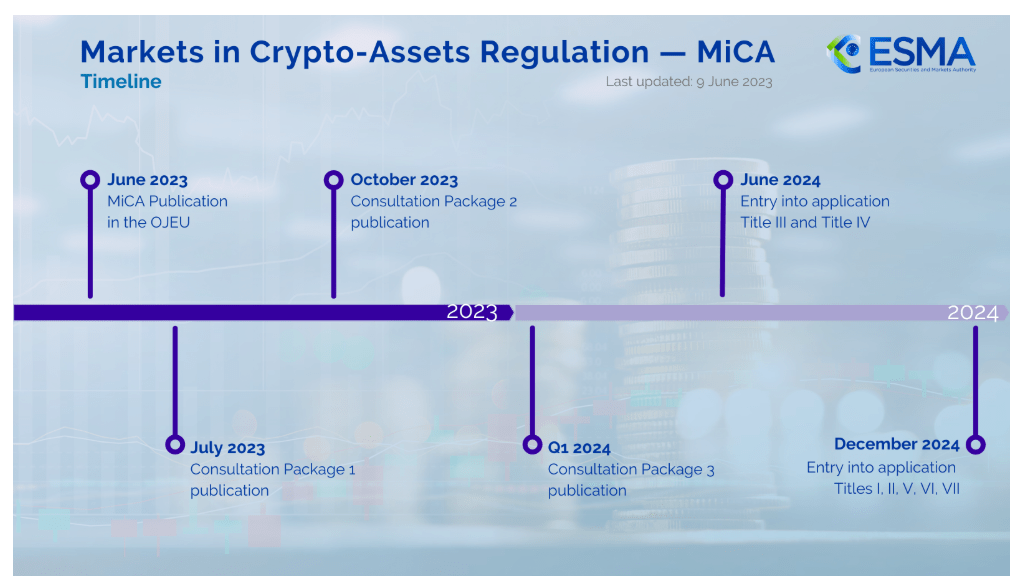
Image Credit: The News Crypto
Major Legislative Changes Affecting the Market
US Debt Ceiling Issue:
On January 2, 2025, the US government reset the debt ceiling to $36.1 trillion, but the issue remains politically contentious, increasing market uncertainty.
Why is it important?
– Uncertainty in fiscal policy exacerbates market volatility.
– Bitcoin is viewed as a safe-haven asset, but historically, debt crises tend to lead to widespread market sell-offs before the market stabilizes.

Image Credit: Visual Capitalist
Policy Changes in Major Economies
New Legislation in Luxembourg:
On February 6, 2025, Luxembourg passed new legislation that integrates EU crypto regulations with green bond regulations, further solidifying its position in the field of digital asset regulation.
Why is it important?
- – Luxembourg's regulatory model may influence other jurisdictions, promoting the unification of global crypto regulatory frameworks.
Changes in regulatory policies will continue to impact market stability, capital flows, and the adoption of cryptocurrencies, making it crucial to stay informed.
Developments in Major Economies and Investor Sentiment
US Economy
The market is focused on whether the Federal Reserve (Fed) can control inflation without triggering a recession.
– Strong labor market + cooling inflation: Positive for the stock market and cryptocurrency market.
– Weak economic data: May trigger risk aversion, leading to capital inflows into the dollar and gold, which is unfavorable for crypto assets.
– Expectations for future rate cuts: If the market believes the Fed will ease monetary policy, it may boost risk assets like Bitcoin.
European Economy
The Eurozone is currently seeking a balance between controlling inflation and economic growth.
If the European Central Bank (ECB) signals a pause in rate hikes, the market may rebound.
Energy prices remain key:
– If the Russia-Ukraine war escalates, rising energy prices may trigger inflation concerns.
– If the energy market stabilizes, it could support economic growth in Europe, benefiting the crypto market.
Chinese Economy
The National People's Congress (NPC) will set the economic growth target for 2025 in March.
– Possible stimulus measures: Infrastructure investment, loose monetary policy, etc., could help drive growth in commodities and emerging markets.
– Although China restricts domestic crypto trading, economic growth still influences global market risk appetite, indirectly affecting cryptocurrency prices.
Emerging Markets
If major central banks pause rate hikes, capital may flow into emerging markets, driving up risk assets and benefiting cryptocurrencies.
- – Potential risks: Debt crises or political instability may trigger risk aversion, leading to capital outflows.
Impact on the Cryptocurrency Market in March
Interest Rates and Market Liquidity
Central bank decisions will directly affect the crypto market:
– Rate hikes: Tighten market liquidity, putting pressure on Bitcoin and other altcoins.
– Pausing rate hikes or cutting rates: May release funds into the market, strengthening speculative sentiment and driving up cryptocurrency prices.
Inflation and the "Store of Value" Narrative
– Cooling inflation: Reduces market concerns about further rate hikes, benefiting crypto market growth.
– If inflation rises again: Central banks may maintain a hawkish stance, weakening market risk appetite, which is unfavorable for cryptocurrencies.
– Bitcoin as "digital gold": Long-term inflation may reinforce Bitcoin's store of value characteristics, but the market remains more focused on interest rate expectations.
Economic Growth and Risk Appetite
– GDP growth and a strong labor market: Generally favorable for risk assets, including cryptocurrencies.
– Economic slowdown: May lead to market sell-offs in the short term, but if the market expects central banks to cut rates, it may provide long-term support for the crypto market.
Geopolitical Safe-Haven Capital Flows
– During crises, market risk aversion rises, and cryptocurrencies typically face pressure.
– If geopolitical instability persists, it may highlight the advantages of cryptocurrencies as decentralized assets, attracting some capital inflows.
Regulatory Dynamics and Market Confidence
– Approval of ETFs, clear regulatory policies, or friendly regulations may drive the market up.
– Bans or lawsuits may increase market uncertainty, leading to significant price volatility.
Market Sentiment and Capital Rotation
– Changes in market liquidity affect the rotation of funds between cryptocurrencies and the stock market.
– Traders should pay attention to volatility during the release of important economic data, as significant price fluctuations may occur in the short term.
免责声明:本文章仅代表作者个人观点,不代表本平台的立场和观点。本文章仅供信息分享,不构成对任何人的任何投资建议。用户与作者之间的任何争议,与本平台无关。如网页中刊载的文章或图片涉及侵权,请提供相关的权利证明和身份证明发送邮件到support@aicoin.com,本平台相关工作人员将会进行核查。




